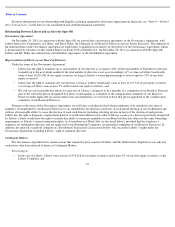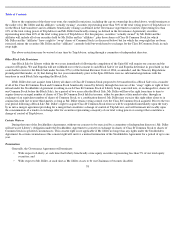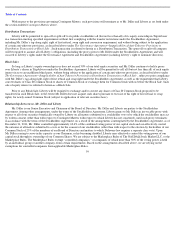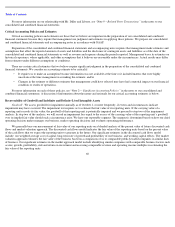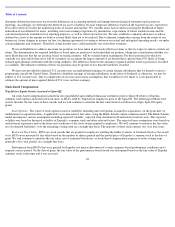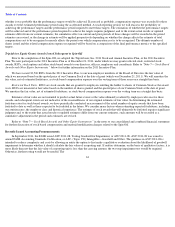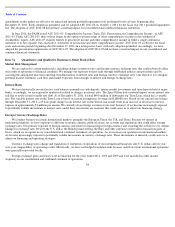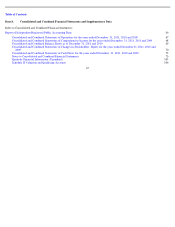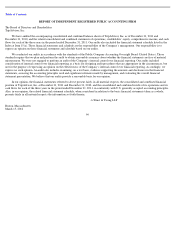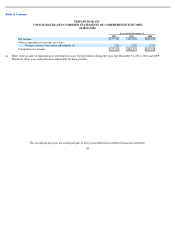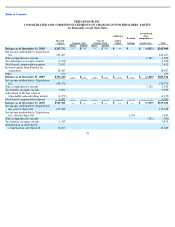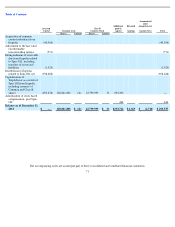TripAdvisor 2011 Annual Report Download - page 65
Download and view the complete annual report
Please find page 65 of the 2011 TripAdvisor annual report below. You can navigate through the pages in the report by either clicking on the pages listed below, or by using the keyword search tool below to find specific information within the annual report.
Table of Contents
We believe the use of discounted cash flows and market approach on a weighted basis is the best method for determining the fair value of
its reporting units because these are the most common valuation methodologies used within the travel and Internet industries; and the blended
use of both models compensates for the inherent risks associated with either model if used on a stand-alone basis.
In September 2011, the Financial Accounting Standards Board, or FASB, issued updated guidance, Accounting Standards Update, or ASU,
2011-08, Testing Goodwill for Impairment, or ASU 2011-08, on the periodic testing of goodwill for impairment. This guidance allows
companies to assess qualitative factors to determine if it is more-likely-than-not that goodwill might be impaired and whether it is necessary to
perform the two-step goodwill impairment test required under current accounting standards. This guidance is applicable for annual and interim
goodwill impairment tests performed for fiscal years beginning after December 15, 2011 with early adoption permitted. On October 1, 2011, we
early adopted this guidance and our adoption did not materially impact our consolidated and combined financial statements. Based on our
assessment of goodwill as of October 1, 2011 and December 31, 2011 (after Spin-Off), using qualitative factors we have concluded there was no
indication of a goodwill impairment and did not find it necessary to perform a two-step goodwill impairment test.
Indefinite-Lived Intangible Assets . In the evaluation of indefinite-lived intangible assets, an impairment charge is recorded for the excess
of the carrying value of the indefinite-lived intangible asset over its fair value. We base our measurement of fair value of indefinite-lived
intangible assets, which consist of trade name and trademarks, using the relief-from-royalty method. This method assumes that the trade name
and trademarks have value to the extent that their owner is relieved of the obligation to pay royalties for the benefits received from them. This
method requires us to estimate the future revenue for the related brands, the appropriate royalty rate and the weighted average cost of capital.
Based on our assessment of indefinite-lived intangibles October 1, 2011 and as of December 31, 2011(after Spin-Off), we have not identified
any circumstances that would warrant an impairment assessment.
Definite-Lived Intangible Assets . Intangible assets with definite lives and other long-lived assets are carried at cost and are amortized on a
straight-line basis over their estimated useful lives of two to ten years. We review the carrying value of long-lived assets or asset groups to be
used in operations whenever events or changes in circumstances indicate that the carrying amount of the assets might not be recoverable. Factors
that would necessitate an impairment assessment include a significant adverse change in the extent or manner in which an asset is used, a
significant adverse change in legal factors or the business climate that could affect the value of the asset, or a significant decline in the
observable market value of an asset, among others. If such facts indicate a potential impairment, we assess the recoverability of an asset group
by determining if the carrying value of the asset group exceeds the sum of the projected undiscounted cash flows expected to result from the use
and eventual disposition of the assets over the remaining economic life of the primary asset in the asset group. If the recoverability test indicates
that the carrying value of the asset group is not recoverable, we will estimate the fair value of the asset group using appropriate valuation
methodologies, which would typically include an estimate of discounted cash flows. Any impairment would be measured as the difference
between the asset group’s carrying amount and its estimated fair value. We have not identified any circumstances that would warrant an
impairment assessment as of December 31, 2011.
The use of different estimates or assumptions in determining the fair value of our goodwill, indefinite-lived and definite-lived intangible
assets may result in different values for these assets, which could result in impairment or, in the period in which an impairment is recognized,
could result in a materially different impairment charge.
Income Taxes
We compute and account for our income taxes on a separate tax return basis. We record income taxes under the liability method. Deferred
tax assets and liabilities reflect our estimation of the future tax consequences of temporary differences between the carrying amounts of assets
and liabilities for book and tax purposes. We
61






